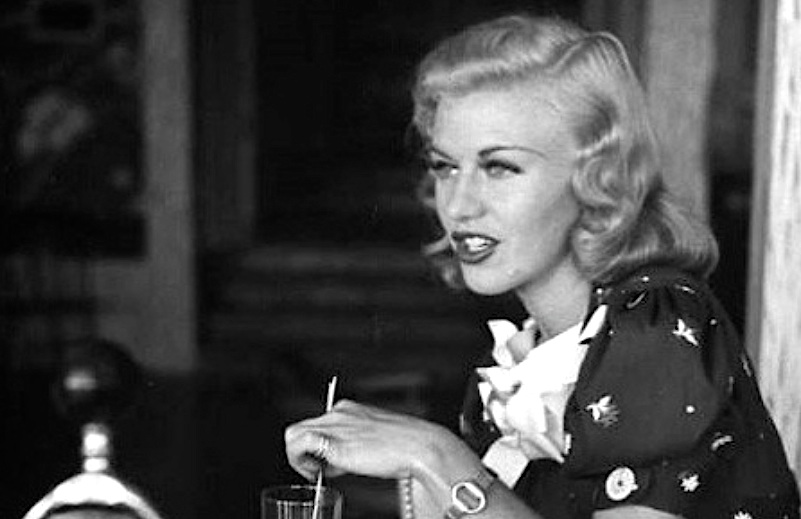How is it possible that today would have been the 106th birthday of gorgeous and talented Ginger Rogers? I saw her twice in the flesh—at a Chicago production of 40 Carats at the Drury Lane Theater years ago and at screening in the early 1990s of one of her most powerful films—the hard-hitting Ku Klux Klan drama Storm Warning co-starring Doris Day and former President Ronald Reagan. Rogers was in a wheelchair by then, but was still dressed to the nines and she enjoyed the warm response from the crowd. She died a few years later, in 1995. If you’ve never seen Storm Warning, you should definitely put it on your list, it’s a phenomenal film . Take a look at the trailer:
Of course I loved the 10 films Ginger made with Fred Astaire (who didn’t?) and I’m glad she eventually got the kudos she deserved for her stellar work in those iconic dance numbers. But when I think of Ginger Rogers today, I am more likely to seek out her non-musical films. Though not always given the same acclaim as other female stars of her era, Ginger Rogers was an amazing actress in dramas as well as comedies. She won a Best Actress Oscar in 1940 for Kitty Foyle, but that was far from my favorite. If I was forced to name my top five Ginger Rogers performances, I would choose “Storm Warning” and the following four:
Stage Door (1937). Oh, how I love this film, directed by Gregory La Cava, based on the play by Edna Ferber and George S. Kaufman, about a group of young wannabe actresses living in a boarding house in New York. Rogers more than holds her own opposite Katharine Hepburn and a bevy of supporting players including Eve Arden, Ann Miller, Lucille Ball, Gail Patrick, and Andrea Leeds not to mention the great Adolph Menjou as a philandering producer. The rapid-fire dialogue is delivered perfectly by the cast, and the transformation of Ginger and Kate’s relationship from one of contempt and loathing to a deep and loving friendship moves me to tears every time. If you’ve never seen this classic film, treat yourself immediately, it’s a total delight.
Bachelor Mother (1939). When you consider the times in which it was made, this film about a single unwed mother was pretty daring. Of course, in this sparkling Garson Kanin comedy, Ginger Rogers is not actually the mother of the abandoned baby she finds, but no matter what she says, the rest of the cast, especially David Niven as her employer-turned-love interest, believes that she is. This absurd tale of mistaken identities gets more complicated as the film progresses, but Rogers is perfect as the title character who eventually falls in love with the tot everyone assumes is her own. My favorite scene involves a New Year’s Eve party where Ginger pretends to be David Niven’s Swedish cousin who speaks no English (“Oppy Neuuu Yeeuhr!”) but still manages to wipe the floor with Niven’s obnoxious ex-girlfriend. Years later, this film was remade as the horrific Bundle of Joy starring real-life newlyweds Debbie Reynolds and Eddie Fisher. Their lack of onscreen chemistry should have given Debbie a clue that there was trouble ahead!
The Major and the Minor (1942). If I had to pick just one favorite Ginger Rogers movie, this first American film written and directed by the great Billy Wilder would be it. In this preposterous story, Rogers, at her most glamorous, is a scalp massager (!) in New York City, but one masher too many has led her to chuck her dreams of making it in the big city and return to her small home town in Iowa. When she gets to the train station, however, she realizes she doesn’t have enough money for the fare. Solution? Dress up as a 12-year-old girl in order to get the half-price fare. On the train she meets the head of a military school played by Ray Milland who, after a series of crazy events, ends up taking Ginger home with him for the weekend. Milland is engaged to a horrible woman (Rogers always seems to be rescuing her male leads from ghastly shrews!) but Ginger, still playing the 12-year-old, falls head over heels for him. Only the girlfriend’s teenaged sister is on to Rogers’ true identity, but she ends up helping Ginger in her quest to nab Niven for herself. In this funny tour-de-force, Ginger Rogers ends up playing three different ages, and her mother, Lela Rogers, shows up as her mother in the film. Again, Ginger’s expert delivery of the crackling dialogue is not to be missed.
I’ll Be Seeing You (1944). Imagine this pitch meeting: Ginger Rogers as a convict from a women’s prison on furlough to visit her family, meets a shell-shocked and mentally ill ex-soldier played by Joseph Cotten. They keep their true identities a secret from each other as they develop a timid and unlikely romance. This ain’t your typical Hollywood film but Ginger gives a wonderful and poignant performance as the down-on-her-luck woman. George Cukor was signed to do the film but was replaced by William Dieterle, a favorite of producer David O. Selznick. A teenaged Shirley Temple appears in the film in one of her first post-child-star roles and is very moving as Rogers’ young cousin.
Other Rogers’ favorites include Vivacious Lady, Fifth Avenue Girl, Roxie Hart, Tender Comrade, Weekend at the Waldorf, Monkey Business, and even Lady in the Dark, a truly bizarre Technicolor musical about psychoanalysis that I saw at this year’s TCM Classic Film Festival. I may not have agreed with Rogers’ politics (she was a lifelong conservative Republican) but that dame sure had all the Right Stuff.
Happy 106th, Ginger!

